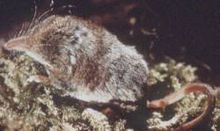Cinereus shrew
| Cinereus shrew | |
|---|---|
 |
|
| Scientific classification | |
| Kingdom: | Animalia |
| Phylum: | Chordata |
| Class: | Mammalia |
| Order: | Eulipotyphla |
| Family: | Soricidae |
| Genus: | Sorex |
| Species: | S. cinereus |
| Binomial name | |
|
Sorex cinereus Kerr, 1792 |
|
 |
|
| Cinereus shrew range | |
The cinereus shrew or masked shrew (Sorex cinereus) is a small shrew found in Alaska, Canada and the northern United States. This is the most widely distributed shrew in North America, where it is also known as the common shrew.
It is grey-brown in colour with a light grey underside and a pointed snout. It has a long tail which is brown on top and pale underneath with a dark tip. Its body is about 9 cm in length including a 4 cm long tail. It weighs about 5 g. It has darker coloring than other shrews. Masked shrews can live up to two years, but averagely only survive eighteen months.
Yom-Tov et al. (2005) found that the masked shrew body size opposes Bergmann’s rule, decreasing with latitude and increasing with January temperatures in Alaska. Also, Yom-Tov et al. (2005) showed that body and tail length increased with rising temperatures during the second half of the twentieth century. This may be due to higher temperatures increasing the availability of the shrews’ diets.
The masked shrew is the most widely distributed shrew (Merritt 1995). Its range covers most of northern North America extending south as far down to Maryland, along the Rocky Mountains in the west, and to the Appalachians in the east. This species was introduced into Newfoundland in the late 1950s. It can be found in many types of habitat like arid grasslands, moist areas, woodland and tundra. The masked shrew mostly lives in humid areas and with high levels of vegetation to hide in. Moisture determines the abundance of this shrew.
Predators include larger shrews, hawks, owls, shrikes, snakes, herons, and foxes, leopard frog, bluebird, brown trout, and weasels. Masked shrews are susceptible to many types of parasites, like fleas and tapeworms (Cowan 2007). Cowan et al. (2007) found that the high volume of food masked shrews consume causes them to be more susceptible to parasitism. Since males have larger ranges they have a higher exposure to parasites (Cowan 2007).
Masked shrews are opportunistic generalists. They eat insects, worms, snails, small rodents, salamanders, and seeds. Due to its high metabolism, the masked shrew can eat three times its weight a day (Whitaker 2004). The shrews have to eat almost constantly because they can only survive a few hours without food (Whitaker 2004). Their metabolism drops when they are at rest.
...
Wikipedia

